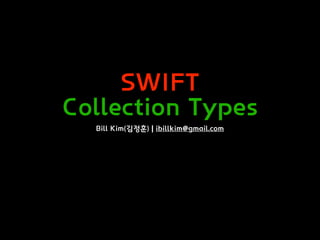
[Swift] Collection types
- 1. SWIFT Collection Types Bill Kim(김정훈) | ibillkim@gmail.com
- 3. Collection Types Swift에서는 콜렉션(리스트) 타입으로 아래의 세가지 형태의 타입 을 지원합니다.
- 4. Array 순서(인데스)가 있는 리스트 형태의 컬렉션 타입 // 빈 Int Array 생성 var integers: Array<Int> = Array<Int>() // 다른 생성 방법 // var integers: Array<Int> = [Int]() // var integers: Array<Int> = [] // var integers: [Int] = Array<Int>() // var integers: [Int] = [Int]() // var integers: [Int] = [] // var integers = [Int]() // 추가 integers.append(1) integers.append(100) print(integers) // [1, 100] // 비었는지 확인 if integers.isEmpty { print("It's empty.") } else { print("It's not empty.") }
- 5. Array // 수정 integers[0] = 99 integers[1] = 10 // 삭제 integers.remove(at: 0) integers.removeLast() integers.removeAll() // 멤버 갯수 확인 print(integers.count) // 배열 순회 for item in integers { print(item) }
- 6. Dictionaries 키와 값의 쌍으로 이루어진 컬렉션 타입입니다. // Key가 String 타입이고 Value가 Any인 빈 Dictionary 생성 var anyDictionary: Dictionary<String, Any> = [String: Any]() // 다른 생성 방법 // var anyDictionary: Dictionary <String, Any> = Dictionary<String, Any>() // var anyDictionary: Dictionary <String, Any> = [:] // var anyDictionary: [String: Any] = Dictionary<String, Any>() // var anyDictionary: [String: Any] = [String: Any]() // var anyDictionary: [String: Any] = [:] // var anyDictionary = [String: Any]() // 추가 anyDictionary["someKey"] = "value" anyDictionary["anotherKey"] = 100 print(anyDictionary) // ["someKey": "value", "anotherKey": 100]
- 7. Dictionaries // 비었는지 확인 if anyDictionary.isEmpty { print("It's empty.") } else { print("It's not empty.") } // 수정 anyDictionary["someKey"] = "dictionary" print(anyDictionary) // ["someKey": "dictionary", "anotherKey": 100] // 삭제 anyDictionary.removeValue(forKey: "anotherKey") anyDictionary["someKey"] = nil print(anyDictionary) // [:] // 멤버 갯수 확인 print(anyDictionary.count) // 0
- 8. Set 순서가 없고 멤버가 유일한 것을 보장하는 컬렉션 값에 대해서 중복 허용 안됨 // 빈 Int Set 생성 var integerSet: Set<Int> = Set<Int>() // 추가 integerSet.insert(1) integerSet.insert(100) integerSet.insert(99) integerSet.insert(99) // 99가 이미 있기 때문에 추가 안됨 integerSet.insert(99) // 99가 이미 있기 때문에 추가 안됨 print(integerSet) // [100, 99, 1] print(integerSet.contains(1)) // true print(integerSet.contains(2)) // false // 비었는지 확인 if anyDictionary.isEmpty { print("It's empty.") } else { print("It's not empty.") }
- 9. Set // 삭제 integerSet.remove(100) integerSet.removeFirst() // 멤버 갯수 확인 print(integerSet.count) // 1 // Set 멤버 순회 for item in integerSet { print("(item)") }
- 10. Set
- 11. Set // Set는 집합 연산에 꽤 유용합니다 let setA: Set<Int> = [1, 2, 3, 4, 5] let setB: Set<Int> = [3, 4, 5, 6, 7] // 합집합 let union: Set<Int> = setA.union(setB) print(union) // [4, 6, 5, 1, 2, 7, 3] // 합집합 오름차순 정렬 let sortedUnion: [Int] = union.sorted() print(sortedUnion) // [1, 2, 3, 4, 5, 6, 7] // 교집합 let intersection: Set<Int> = setA.intersection(setB) print(intersection) // [3, 5, 4] // 차집합 let subtracting: Set<Int> = setA.subtracting(setB) print(subtracting) // [2, 1] // 대칭차 let symDiffSet: Set<Int> = setA.symmetricDifference(setB) print(symDiffSet) // [6, 2, 7, 1]
- 12. Set a는 b의 Superset b는 a의 Subset b와 c는 서로 Disjoint 관계
- 13. Set let houseAnimals: Set = ["🐶 ", "🐱 "] let farmAnimals: Set = ["🐮 ", "🐔 ", "🐑 ", "🐶 ", "🐱 "] let cityAnimals: Set = ["🐦 ", "🐭 "] // isSubset(of:) : A.isSubset(of:B) : A가 B의 부분집합이면 true 아니면 false 반환 // isSuperset(of:) : B.isSuperset(of:A) : B가 A의 상위 집합이면 true 아니면 false 반환 // isStrictSubset(of:) : subset이면서 subset != superset이면 true 아니면 false 반환 // isStrictSuperset(of:) : superset이면서 subset != superset이면 true 아니면 false 반환 // isDisjoint(with:) : 두 집합 사이에 어떤 공통 값이 없을 때 true, 하나라도 있으면 false 반환 print(houseAnimals.isSubset(of: farmAnimals)) // 참(true) print(farmAnimals.isSuperset(of: houseAnimals)) // 참(true) print(houseAnimals.isStrictSubset(of: farmAnimals)) // 참(true) print(farmAnimals.isStrictSuperset(of: houseAnimals)) // 참(true) print(farmAnimals.isDisjoint(with: cityAnimals)) // 참(true)
- 14. References [1] 콜렉션 타입 (Collection Types) : https:// jusung.gitbook.io/the-swift-language-guide/language- guide/04-collection-types [2] 컬렉션 타입 : https://yagom.github.io/swift_basic/ contents/03_collection_types/ [3] [Swift]Collection Types 정리 : http:// minsone.github.io/mac/ios/swift-collection-types- summary [4] [Swift 공부] 컬렉션 타입이란 ? : https:// noahlogs.tistory.com/14 [5] Swift – 함수, 콜렉션 타입 : https://blog.yagom.net/528/
- 15. References [6] Swift - 컬렉션 타입(Collection Types) : http:// seorenn.blogspot.com/2014/06/swift-collection-types.html [7] [Swift 3] 컬렉션 타입 (Collection Types_Array, Set, Dictionary) : https://beankhan.tistory.com/155 [8] 컬렉션 타입(Collection Types) : https://kka7.tistory.com/141 [9] 3 swift 컬렉션 : https://www.slideshare.net/ donggyupark2/3-swift-56764853 [10] [Swift] 016 Working with Collection (컬렉션 사용하기) for beginners : https://creativeworks.tistory.com/entry/ Swift-016-Working-with-Collection-컬렉션-사용하기-for- beginners
- 16. Thank you!
